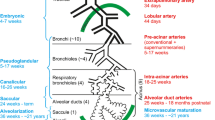Summary
-
1.
Oxygen uptake and ventilatory volume changes were measured on individual book lungs of the tarantula,Eurypelma californicum, using micromanometers (Fig. 1). Heart activity was recorded by manometers mounted on the dorsal cuticle of the opisthosoma.
-
2.
Three types of tidal volume changes were observed (Fig. 2): Type I, heart-synchronous oscillations with a peak-to-peak amplitude of usually 0.01–0.02 μl; Type II, less frequent changes with an amplitude of ca. 0.04–0.08 μl; and sometimes Type III, pulses with a maximum amplitude of ca. 0.7 μl. Type II and III ventilatory movements occur typically during recovery from activity. These tidal volumes represent only 0.2%, 0.8%, and 9% of the lung volume, respectively. The ventilatory volume changes appear to be caused by movements of the posterior wall of the lung atrium.
-
3.
Simultaneous recording of O2 uptake and tidal volume, appropriately filtered (Fig. 3) shows that oxygen uptake per ‘breath’ exceeds the tidal volume of ventilation Type I (Figs. 3, 4) by a factor of ca. 3.
-
4.
After ‘burst activity’,\(\dot V_{O_2 }\) may reach 8 times the resting value. This increase of oxygen consumption was seen even if Type II or Type III ventilation were virtually absent (Fig. 5).
-
5.
During burst activity, oxygen uptake often decreases, or even ceases (Fig. 5). The spiracles were seen to close during intense activity.
-
6.
Using\(\dot V_{O_2 }\) values at rest and during recovery, anatomical data of the book lungs (Table 1) and Angersbach's (1978) data of hemolymph\(P_{O_2 }\)'s, the\(P_{O_2 }\) gradients (1) from ambient air through the atrium to the openings of the lamellae (air sacs), (2) from there through the lamellae, and (3) across the lung wall were calculated (Table 2). These estimates indicate that diffusion alone can always account for the measured oxygen uptake. The atrial diffusion resistance, defined by the width of the spiracles and the geometry of the lung atrium, is a limiting factor for oxygen uptake at rest. After locomotory activity, the lung wall becomes the limiting diffusion barrier.
-
7.
It is concluded that tarantula lungs are essentially diffusion lungs.
Similar content being viewed by others
References
Anderson JF (1970) Metabolic rates of spiders. Comp Biochem Physiol 33:51–72
Anderson JF, Prestwich KN (1980) Scaling of subunit structures in book lungs of spiders (Araneae). J Morphol 165:167–174
Anderson JF, Prestwich KN (1982) Respiratory gas exchange in spiders. Physiol Zool 55:72–90
Anderson JF, Prestwich, KN (1985) The physiology of exercise at and above maximal aerobic capacity in a theraphosid (tarantula) spider,Brachypelma smithi. J Comp Physiol B 155:529–539
Angersbach D (1978) Oxygen transport in the blood of the tarantulaEurypelma californicum: \(P_{O_2 }\) and pH during rest, activity and recovery. J Comp Physiol 123:113–125
Dejours P (1981) Principles of comparative respiratory physiology. Elsevier/North-Holland Biomedical Press; Amsterdam New York Oxford
Focke P (1981) Zur Ventilation von Spinnen: Morphologische und physiologische Untersuchungen an der VogelspinneEurypelma californicum. Diploma Thesis, University of Munich, Faculty of Biology
Herreid CF (1981) Energetics of pedestrian arthropods. In: Herreid CF, Fourtner CR (eds) Locomotion and energetics in arthropods. Plenum Press, New York, pp 491–526
Herreid CF, Full RJ (1980) Energetics of running tarantulas. Physiologist 23:40
Hill DE (1977) Some observations on the physiology of livingLyssomanes viridis which should apply to the Araneae in genera. Peckhamia 1:41–44
Kästner A (1929) Bau und Funktion der Fächertracheen einiger Spinnen. Z Morphol Ökol Tiere 13:463–558
Krogh A (1941) The comparative physiology of respiratory mechanisms. Philadelphia, University of Pennsylvania Press
Paul R, Fincke T, Tiling K (1986a) Respiration and circulation in tarantulas. In: Barth FG (ed) Verhandl Dtsch Zool Ges, pp 352
Paul R, Storz H, Tiling K, Fincke T, Linzen B (1986b) Circulation, respiration and metabolism in active tarantulas (Eurypelma californicum). Conf Comp Physiol Environ Adapt, Strasbourg (Abstract)
Schmidt-Nielsen K (1985) Scaling. Cambridge University Press, Cambridge
Stahl WR (1967) Scaling of respiratory variables in mammals. J Appl Physiol 22:453–460
Stewart DM, Martin AW (1974) Blood pressure in the tarantula,Dugesiella hentzi. J Comp Physiol 88:141–172
Strazny F, Perry SF (1984) Morphometric diffusing capacity and functional anatomy of the book lungs in the spiderTegenaria spp. J Morphol 182:339–354
Willem V (1917) Observations sur la circulation sanguine et la respiration pulmonaire chez les Araignées. Arch Neerl Physiol Ser 3, 1:226–256
Author information
Authors and Affiliations
Additional information
Dedicated to Professor H. Autrum on the occassion of his 80th birthday
Rights and permissions
About this article
Cite this article
Paul, R., Fincke, T. & Linzen, B. Respiration in the tarantulaEurypelma californicum: evidence for diffusion lungs. J Comp Physiol B 157, 209–217 (1987). https://doi.org/10.1007/BF00692365
Accepted:
Issue Date:
DOI: https://doi.org/10.1007/BF00692365




